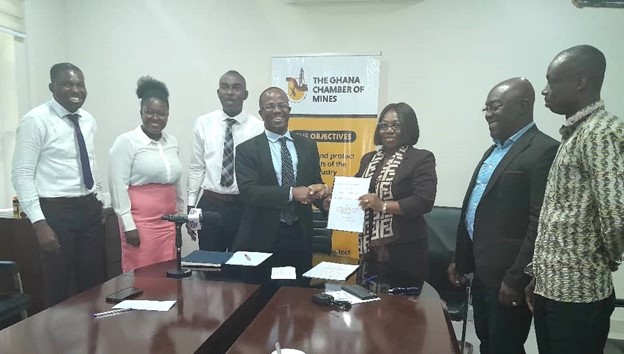By Kizito CUDJOE
The Ghana Chamber of Mines has announced a substantial investment of US$219,318 into the University of Mines and Technology (UMaT) over a three-year period from 2024 to 2026.
The funding aims to support research in improving gold recovery methods, especially from carbonaceous ore bodies, which have historically challenged the mining industry due to their resistance to conventional processing methods.
Dr. Sulemanu Koney, the Chief Executive of the Chamber, underscored the significance of finding innovative solutions to enhance recovery rates, which currently stand at a low 35 percent. The investment, he explains, is in line with the chamber’s commitment to leveraging UMaT’s expertise to boost recoveries to 90 percent, thereby increasing the efficiency and profitability of gold mining operations in Ghana.
“We are optimistic that this support will produce results that will address the perennial low recovery associated with carbonaceous ore bodies. This will benefit Ghana’s mining industry and the larger global mining industry,” he stated.
In 2019, the Ghana Chamber of Mines set up a Tertiary and Education Fund (TEF) to support teaching and learning in tertiary institutions. The fund committed over US$2million to the first beneficiary institution, UMaT, in its first phase – 2019 to 2023.
Dr. Koney further disclosed that the chamber’s support to UMaT has renewed for another five years, and there are plans to commit over US$2million for the second phase.
The research at UMaT, supported by this significant investment, will concentrate on pioneering new techniques and technologies for gold recovery.
If successful, these innovations could have profound implications for the mining industry not only in Ghana, but potentially worldwide. The partnership will also facilitate the development and utilisation of the capabilities of two PhD students from the university, as highlighted by the Chamber of Mines boss.
In response, the Vice Chancellor of UMaT, Prof. Richard Amankwah, acknowledged the long-standing partnership between the university and the chamber.
Regarding the research supported by the grant, he admitted that carbonaceous ore bodies have long been a challenge for the mining industry, noting that previous solutions have not endured over time. However, he outlined ongoing research showing promising potential to effectively enhance gold recovery from these ore bodies, prompting the chamber to extend its support to expand the study.
“This kind of support that we are getting today is a game-changer in the minerals industry. I want to believe that we are going to do a good job in the university,” he stated.
Assuming all conditions remain constant, Prof. Amankwah reaffirmed plans to train two PhD students and three postgraduate students for the study. He mentioned that this initiative will provide valuable hands-on experience for others in managing the enhanced gold recovery processes.
He said: “We are going to build, for the first time, a pilot gold processing plant in the university. So that after the project has been done, we will a sitting pilot plant in the university that can be used possibly for a five-tonne per day operation”.
The availability of this plant, he said, will allow students pursuing the metallurgy programme at UMaT to gain hands-on knowledge on how to run a processing plant even before they complete their studies.










